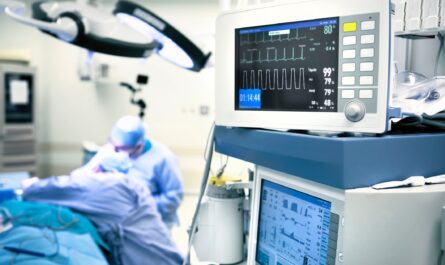Robotic prosthetics are artificially engineered limbs, which are powered by battery, microprocessors and software are capable of restoring mobility and independence to amputees. Technological advancements have enabled prosthetics to replicate most of the functions of natural limbs such as grasping, lifting and moving in multi-dimensional planes.
This enhances the quality of life of amputees by closely mimicking the appearance and functionality of natural limbs. The increasing number of amputee patients due to the rising incidence of chronic diseases like diabetes and road accidents has been a driving factor for Robotic Prosthetics market.
The Global robotic prosthetics Market is estimated to be valued at US$ 1.60 Bn in 2024 and is expected to exhibit a CAGR of 9.5% over the forecast period 2024-2031.
Key Takeaways
Key players operating in the Global Robotic Prosthetics are Ottobock, Ossur, Blatchford Group, HDT Global, Fillauer LLC, Steeper Inc., Proteor, PROTUNIX, Endolite and Deka Research and Development Corporation. These key players are focusing on R&D activities to develop advanced technologies like myoelectric control systems, anthropic robotic hands, smart sockets and sensors to provide human-like movement in prosthetic limbs for a wide range of amputations.
The increasing demand for user-friendly, lightweight and multifunctional prosthetics present substantial growth opportunities for market players. Myoelectric control systems are gaining popularity due to better control experience compared to body-powered systems. The use of 3D printing for prosthetics customization as per patient’s anatomical structure offers tremendous opportunities.
Globally, North America dominates the robotic prosthetics owing to presence of major players and rising adoption of advanced technologies. However, Asia Pacific is expected to witness highest growth due to rapidly increasing aging population, rising incidence of diabetes and improved healthcare expenditure. Countries like China, Japan and India offer lucrative opportunities for market expansion.
Market Drivers
The rapid technological advancements in material science, electronics miniaturization, neural interfaces and powered components have enabled the development of dexterous and anthropic prosthetics. The growing R&D investments by governments and private organizations to develop low-cost solutions is positively impacting the market growth. In addition, the increasing healthcare expenditure on rehabilitation and support for amputees drive the demand for robotic prosthetics over the forecast period.
PEST Analysis
Political: Government regulations regarding healthcare reforms and increase in funding for medical device development will positively impact the robotic prosthetics market.
Economic: As disposable incomes rise, patients will have greater access to advanced robotics for prosthetics treatment. Insurance coverage expansion will also fuel market growth.
Social: Growing geriatric population and rising incidence of amputations due to chronic diseases, injuries and accidents will increase demand for bionic limb replacement.
Technological: Developments in areas of robotics, 3D printing, miniaturization and material science will enhance product functionality. Integration of myoelectric sensors and Bluetooth technology enable more intuitive prosthetic control and use.
The market in terms of value is currently concentrated in North America and Europe due to advanced healthcare infrastructure and greater awareness about robotic prosthetics. Asia Pacific is poised to be the fastest growing regional market over the forecast period with China and India experiencing increased adoption. Growth momentum will be supported by rising medical tourism, healthcare reforms and expanding manufacturing facilities of major players in these nations. The young, geriatric population base along with growing incidence of diabetes and road accidents also present opportunities for market expansion.
Geographical regions where market in terms of value is concentrated are North America and Europe. Both regions have advanced healthcare infrastructure, higher healthcare spends per capita, favorable reimbursement policies and greater patient access to robotic prosthetics due to presence of major manufacturers. The fastest growing region is Asia Pacific due to rising geriatric population, expanding medical tourism industry, healthcare reforms and increasing local manufacturing facilities of global companies in countries such as China and India. Surging incidence of chronic diseases and road accidents also presents opportunities for market growth in Asia Pacific.
What Are The Key Data Covered In This Global Robotic Prosthetics Market Report?
:- Market CAGR throughout the predicted period
:- Comprehensive information on the aspects that will drive the Global Robotic Prosthetics’s growth between 2024 and 2031.
:- Accurate calculation of the size of the Global Robotic Prosthetics and its contribution to the market, with emphasis on the parent market
:- Realistic forecasts of future trends and changes in consumer behaviour
:- Global Robotic Prosthetics Industry Growth in North America, APAC, Europe, South America, the Middle East, and Africa
:- A complete examination of the market’s competitive landscape, as well as extensive information on vendors
:- Detailed examination of the factors that will impede the expansion of Global Robotic Prosthetics vendors
FAQ’s
Q.1 What are the main factors influencing the Global Robotic Prosthetics?
Q.2 Which companies are the major sources in this industry?
Q.3 What are the market’s opportunities, risks, and general structure?
Q.4 Which of the top Global Robotic Prosthetics companies compare in terms of sales, revenue, and prices?
Q.5 Which businesses serve as the Global Robotic Prosthetics’s distributors, traders, and dealers?
Q.6 How are market types and applications and deals, revenue, and value explored?
Q.7 What does a business area’s assessment of agreements, income, and value implicate?
*Note:
1. Source: Coherent Market Insights, Public sources, Desk research
2. We have leveraged AI tools to mine information and compile it
About Author - Money Singh
Money Singh is a seasoned content writer with over four years of experience in the market research sector. Her expertise spans various industries, including food and beverages, biotechnology, chemical and materials, defense and aerospace, consumer goods, etc. LinkedIn Profile



